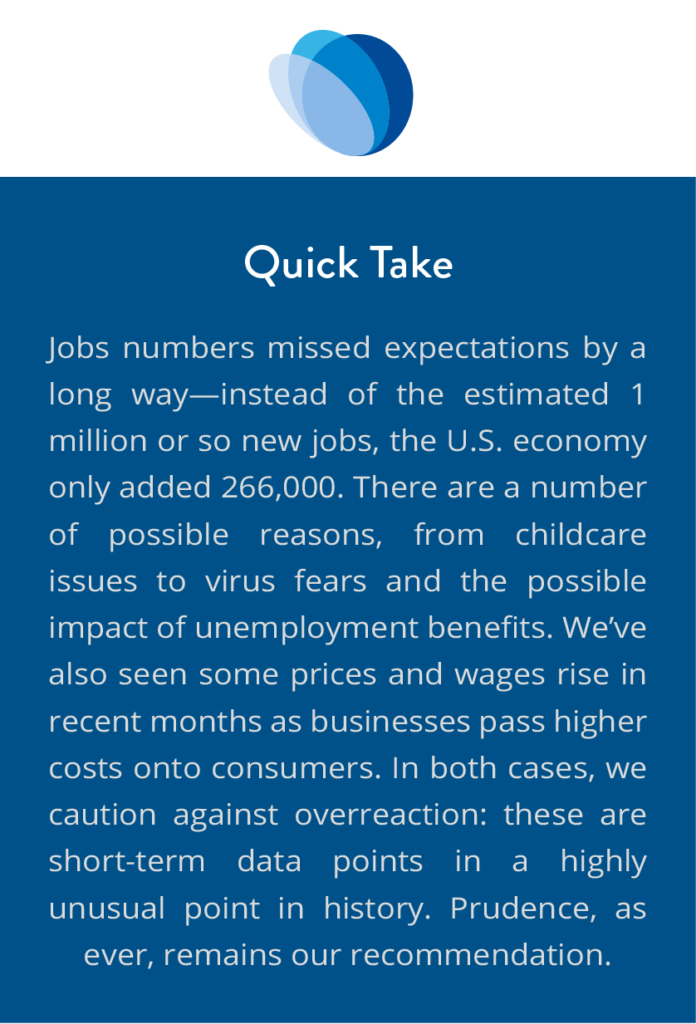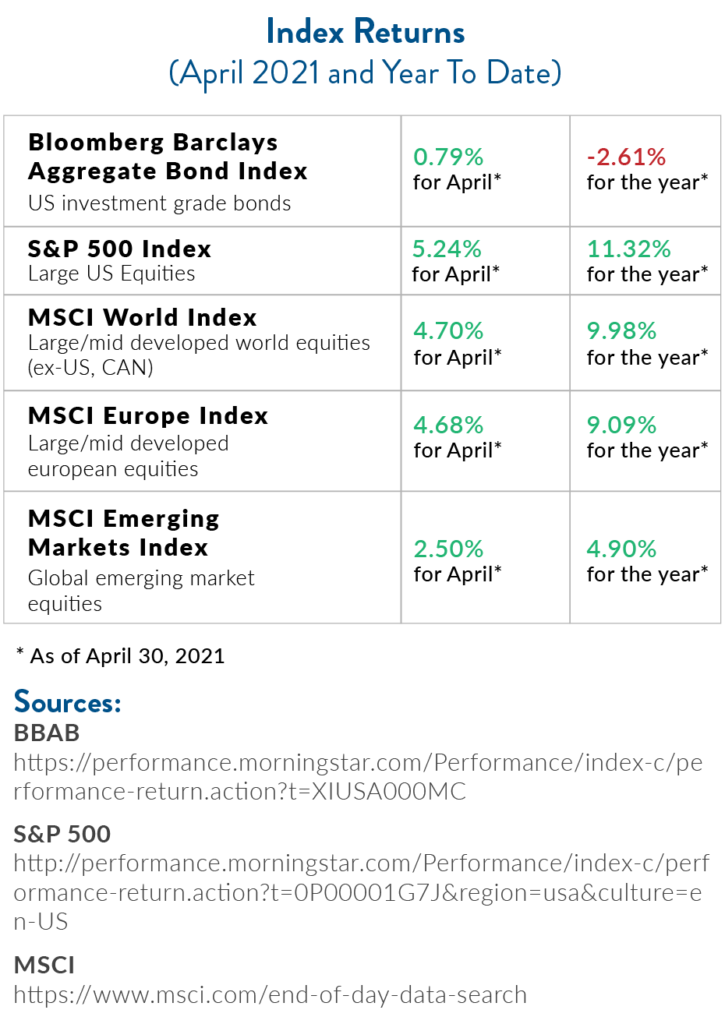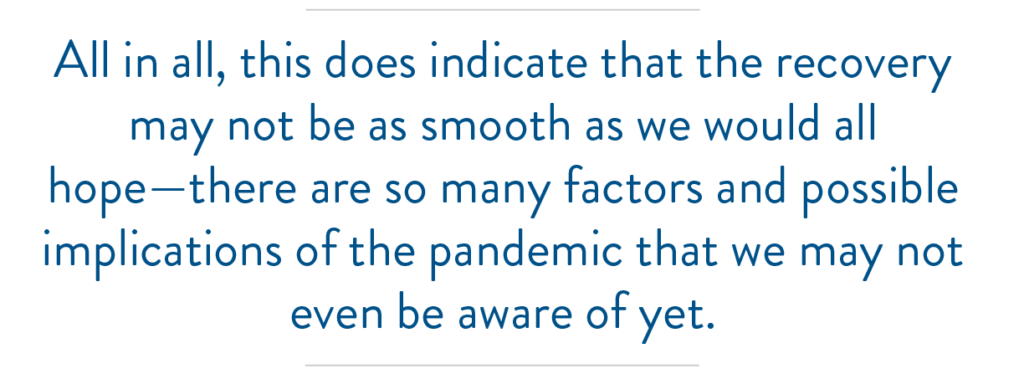April Jobs Miss Expectations
Equities reached new highs in April, the Federal Reserve re-confirmed its commitment to supporting the economy, and first-quarter economic growth hit a 6.4% annualized rate. However, surprisingly weak jobs growth in April took economy-watchers by surprise.
What happened? Let’s take a closer look.
 Jobs Growth Stalls
Jobs Growth Stalls
Expectations were that jobs growth would come in at just shy of 1 million in April, according to Bloomberg, and at 900,000 according to Moody’s Analytics. March jobs growth was initially announced at 916,000; the U.S. economy added 1.3 million jobs between February and March, and about 1 million jobs over the preceding five months.[1]
In other words, expectations were that this momentum would continue.
Instead, April employment figures showed just 266,000 new jobs and the unemployment rate ticked up slightly, to 6.1%.[2] However, more people also entered the workforce in April—with more people looking for jobs, it makes sense that this number would move a bit higher.
 Overall, the U.S. is still 8 million jobs short of pre-pandemic levels. At the same time, there are a large number of unfilled jobs, and some corporate officials have stated that they’re having trouble finding workers.[3]
Overall, the U.S. is still 8 million jobs short of pre-pandemic levels. At the same time, there are a large number of unfilled jobs, and some corporate officials have stated that they’re having trouble finding workers.[3]
A Complicated Return to Work
Federal Reserve Chair Jerome Powell cited a few possible reasons: namely, a skills gap in open jobs, ongoing childcare obligations where schools are still virtual, and continued fears about being at work and COVID-19 exposure.[4] The family/childcare impact is difficult to hone in on, but women dropped out of the workforce in April for the first time since January, after months of steady improvement.[5]
Others have pointed to the potential impact of unemployment benefits and stimulus on workers’ desire to return to work.[6] Neel Kashkari, president of the Federal Reserve Bank of Minneapolis, pointed to federal unemployment benefits as a possible “disincentive” for workers to return. The Wall Street Journal estimates that with additional federal benefits, the average person receiving unemployment benefits earns more than they would full-time at $15 per hour.
 There are also indications that wages might be rising—both wages and hours worked increased in April, a possible sign that companies are paying more to lure workers back to open jobs.
There are also indications that wages might be rising—both wages and hours worked increased in April, a possible sign that companies are paying more to lure workers back to open jobs.
All in all, this does indicate that the recovery may not be as smooth as we would all hope—there are so many factors and possible implications of the pandemic that we may not even be aware of yet.
 As we’ve indicated before, we think it makes sense to continue to be optimistic but prudent, and to, as always, not let the highs get us too high or the lows get us too low. There is no roadmap for this recovery, which means there could be more surprises.
As we’ve indicated before, we think it makes sense to continue to be optimistic but prudent, and to, as always, not let the highs get us too high or the lows get us too low. There is no roadmap for this recovery, which means there could be more surprises.
What About Inflation?
You may have noticed some prices going up—the Consumer Price Index rose 2.6% for the year ending in March 2021. Nearly half of this jump is related to gas prices, which have endured significant production problems due to winter weather.[7]
As we’ve noted before, the Fed expects a temporary increase in inflation this year as a result of the recovery and pent-up demand.[8] Fed Chairman Powell has stated that the Fed would need to see sustained inflation of over 2% before raising rates—both to help ensure that the recovery has truly taken hold and to compensate for a decade of below-target inflation.
Higher costs are also being driven by supply chain issues, materials shortages, and to make up for last year—some manufacturers didn’t pass their own higher costs onto consumers during 2020.[9]
Again, the road map here is, to a degree, uncertain. We don’t think it’s a good idea to assume that we know what’s coming next, but rather to focus on prudent and cautious planning that accounts for various possibilities.
 Please note, amended 1099s may now be available for certain accounts. We are also quickly approaching May 17, 2021 – the extended IRS 2020 federal tax filing date for individuals as well as the contribution deadline for IRAs. If you have any questions, contact us at the office.
Please note, amended 1099s may now be available for certain accounts. We are also quickly approaching May 17, 2021 – the extended IRS 2020 federal tax filing date for individuals as well as the contribution deadline for IRAs. If you have any questions, contact us at the office.
In observance of Shavuot, JSF will be closed on Monday, May 17, 2021. However, we will still have a small team in the office that day for any immediate needs or questions. For assistance, please call the office at 323.866.0833 and ask for an operations team member.
As always, we encourage you to reach out to our office with your questions and concerns, whether about markets or the economy. We’re here to help you navigate this unprecedented moment in history for yourself and your family.

Download print version of this article
The information expressed herein are those of JSF Financial, LLC, it does not necessarily reflect the views of Mid Atlantic Capital Corporation (MACC). Neither JSF Financial LLC nor MACC gives tax or legal advice. All opinions are subject to change without notice. Neither the information provided, nor any opinion expressed constitutes a solicitation or recommendation for the purchase or sale of any security. Investing involves risk, including possible loss of principal. Indexes are unmanaged and cannot be invested in directly.
Historical data shown represents past performance and does not guarantee comparable future results. The information and statistical data contained herein were obtained from sources believed to be reliable but in no way are guaranteed by JSF Financial, LLC or MACC as to accuracy or completeness. The information provided is not intended to be a complete analysis of every material fact respecting any strategy. The examples presented do not take into consideration commissions, tax implications, or other transactions costs, which may significantly affect the economic consequences of a given strategy. Diversification does not ensure a profit or guarantee against loss. Carefully consider the investment objectives, risks, charges and expenses of the trades referenced in this material before investing.
Asset Allocation and Diversification do not guarantee a profit or protect against a loss.
The Bloomberg Barclays U.S. Aggregate Bond Index measures the investment-grade U.S. dollar-denominated, fixed-rate taxable bond market and includes Treasury securities, government-related and corporate securities, mortgage-backed securities, asset-backed securities and commercial mortgage-backed securities.
The S&P 500 Index is an unmanaged, market value-weighted index of 500 stocks generally representative of the broad stock market.
The MSCI World Index is a broad global equity index that represents large and mid-cap equity performance across 23 developed markets countries and covers approximately 85% of the free float-adjusted market capitalization in each country.
The MSCI Europe Index captures large and mid-cap representation across 15 developed markets countries in Europe and covers approximately 85% of the free float-adjusted market capitalization across the European Developed Markets equity universe.
The MSCI Emerging Markets Index captures large and mid-cap representation across 26 emerging markets countries and covers approximately 85% of the free float-adjusted market capitalization in each country.
Gross domestic product (GDP) is a monetary measure of the market value of all the final goods and services produced in a specific time period. GDP is the most commonly used measure of economic activity.
By clicking on these links, you will leave our server, as they are located on another server. We have not independently verified the information available through this link. The link is provided to you as a matter of interest. Please click on the links below to leave and proceed to the selected site.
Sources:
[1]: https://www.moodys.com/researchdocumentcontentpage.aspx?docid=PBC_1282980
[2]: https://www.bloomberg.com/news/articles/2021-05-07/softer-u-s-april-job-growth-indicates-challenges-to-recovery?cmpid=BBD050721_BIZ&utm_medium=email&utm_source=newsletter&utm_term=210507&utm_campaign=bloombergdaily&sref=c4RUGNV1
[3]: https://www.bloomberg.com/news/articles/2021-05-07/softer-u-s-april-job-growth-indicates-challenges-to-recovery?cmpid=BBD050721_BIZ&utm_medium=email&utm_source=newsletter&utm_term=210507&utm_campaign=bloombergdaily&sref=c4RUGNV1
[4]: https://www.bloomberg.com/news/articles/2021-05-07/softer-u-s-april-job-growth-indicates-challenges-to-recovery?cmpid=BBD050721_BIZ&utm_medium=email&utm_source=newsletter&utm_term=210507&utm_campaign=bloombergdaily&sref=c4RUGNV1
[5]: https://www.bloomberg.com/news/articles/2021-05-07/women-leaving-workforce-again-shows-uneven-u-s-jobs-recovery?sref=c4RUGNV1
[6] This section: https://www.wsj.com/articles/policy-makers-cant-agree-on-causes-of-shortage-of-workers-11620585556?mod=hp_major_pos2#cxrecs_s
[7]: https://www.wsj.com/articles/us-inflation-consumer-price-index-march-2021-11618273541?mod=article_inline
[8]: https://www.wsj.com/articles/federal-reserve-interest-rates-bond-purchases-march-2021-11615917632?mod=article_inline
[9]: https://www.wsj.com/articles/consumers-adjust-to-higher-prices-11620552601?mod=trending_now_news_pos2
Performance table sources:
BBAB: https://performance.morningstar.com/Performance/index-c/performance-return.action?t=XIUSA000MC
